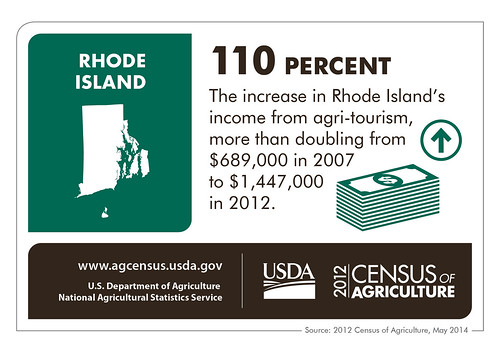
The Census of Agriculture is the most complete account of U.S. farms and ranches and the people who operate them. Every Thursday USDA’s National Agricultural Statistics Service will highlight new Census data and the power of the information to shape the future of American agriculture.
Rhode Island may be one of the smallest States in terms of agriculture but the 2012 Census of Agriculture shows Rhode Island has something most states don’t have – more farmers. The number of farmers in Rhode Island tallied 1,243, up slightly from 1,219 in 2007. As of 2012, almost 70,000 acres of our land are now dedicated to farming. That’s quite a bit, if you consider the fact that we are the smallest state in the Union.
Our agricultural growth is boosted by the “buy local” movement. According to the Census, Rhode Island growers sold almost $6.3 million worth, or 10.5 percent, of our agricultural products directly to consumers in 2012. This is the second highest percentage in the nation.
While sales of products from nurseries, greenhouses, and sod farms are still the largest economic contributor to Rhode Island’s agricultural economy (about 55 percent), this sector has not yet fully recovered from the economic downturn. Most of Rhode Island’s farms with sales above $50,000 belong to this sector while farms with less than $50,000 are a more diversified group with several fruit, vegetable, other crop, aquaculture, and livestock farms as well as nurseries, greenhouses, and sod farms. These smaller farms are responsible for the overall increase in farm numbers.
More Rhode Island farmers have incorporated new marketing approaches, such as agri-tourism as a way to improve farm income. Income from agri-tourism more than doubled from $689,000 in 2007 to $1,447,000 in 2012. In addition, 139 of our farms sold value-added commodities, such as bread, jam, and cheese. And to further narrow the gap between urban and rural life, 50 Rhode Island farms marketed their products through Community Supported Agriculture arrangements in 2012.
These are just some of the key trends in Rhode Island agriculture. There are plenty more facts to be found in the 2012 Census and once the upcoming 2017 Census of Agriculture is conducted, we’ll discover an even more complete picture of farming in our state. And while I cannot predict what will happen in the future, I know that there is a lot of potential for Rhode Island farming in the upcoming years.
